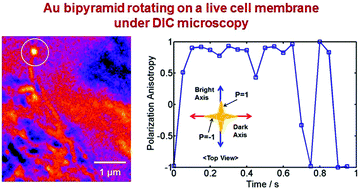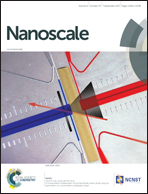Single gold bipyramids with sharp tips as sensitive single particle orientation sensors in biological studies†
Abstract
Plasmonic gold bipyramids (AuBPs) with sharp tips are promising orientation probes in biological studies because of their anisotropic shape, strong electric field enhancement at the tips, and convenient manipulation into other shapes. Herein, we elucidate the optical properties of single AuBPs at their localized surface plasmon resonance (LSPR) wavelengths using dark-field (DF) microscopy and differential interference contrast (DIC) microscopy and test their use as orientation probes in a dynamic biological environment. Characteristic scattering field distributions together with a simulation study allowed us to achieve the high-throughput determination of the 3D orientation of single AuBPs within a single frame using defocused DF microscopy. We further present the polarization-dependent, periodic DIC images and intensities of single AuBPs at their LSPR wavelengths with high sensitivity. Finally, we successfully tracked the real-time rotational motions of transferrin-modified AuBPs on live cell membranes using DIC microscopy. Therefore, these results support the use of single AuBPs as sensitive orientation probes in dynamic biological studies using DIC microscopy.



 Please wait while we load your content...
Please wait while we load your content...